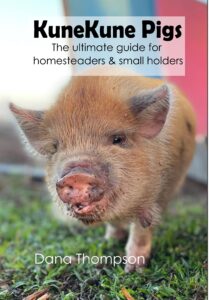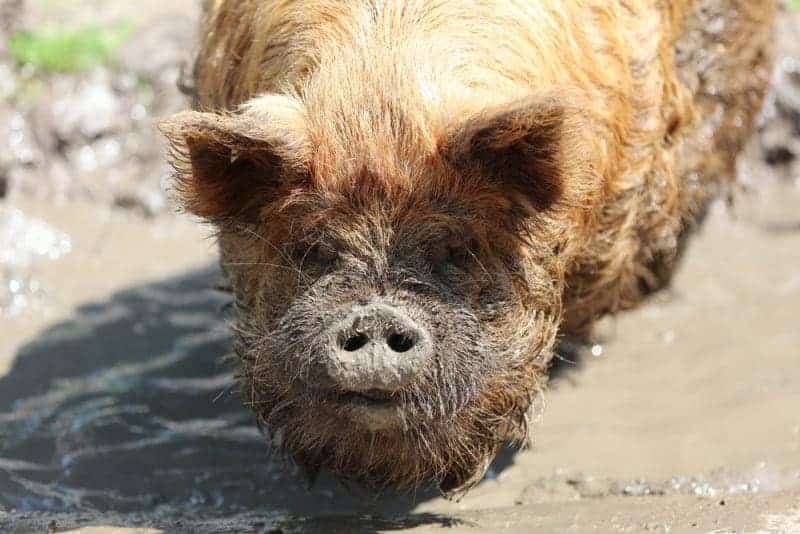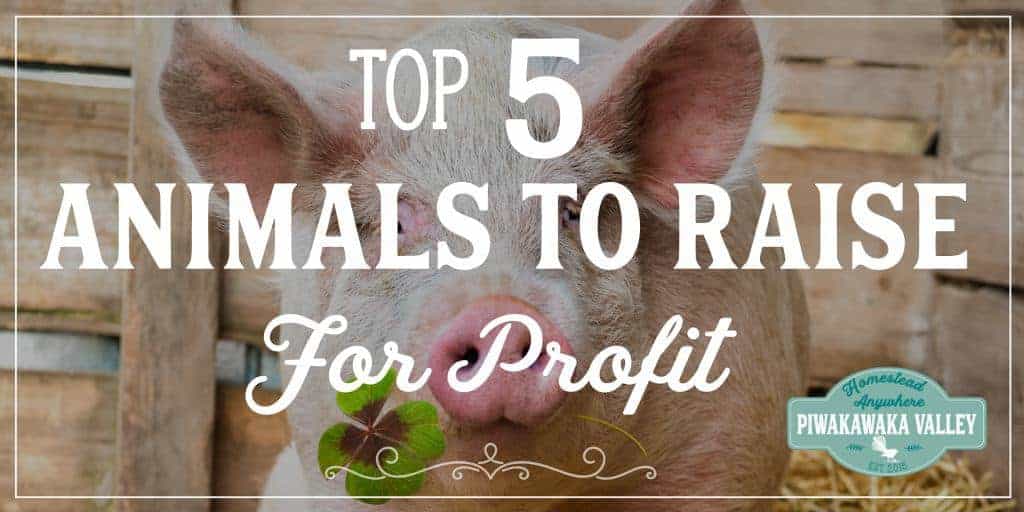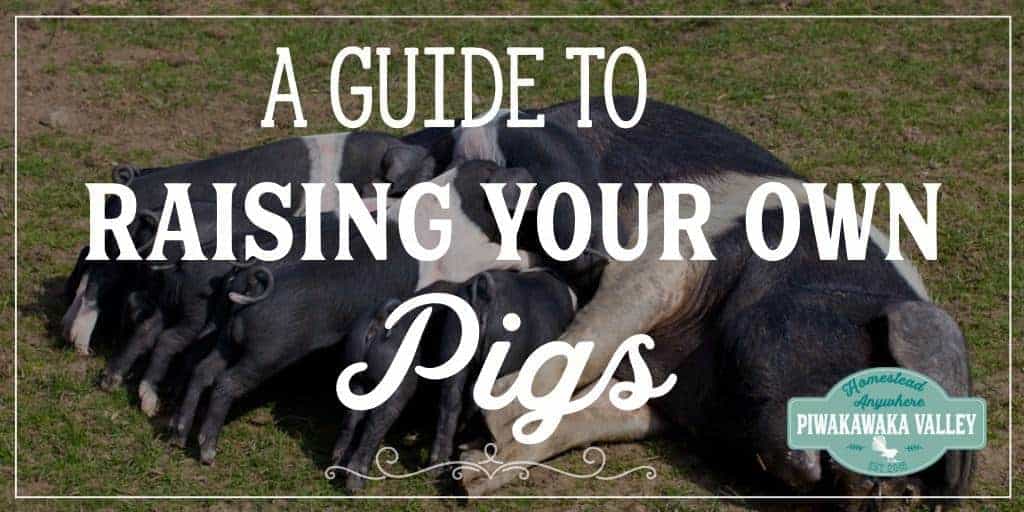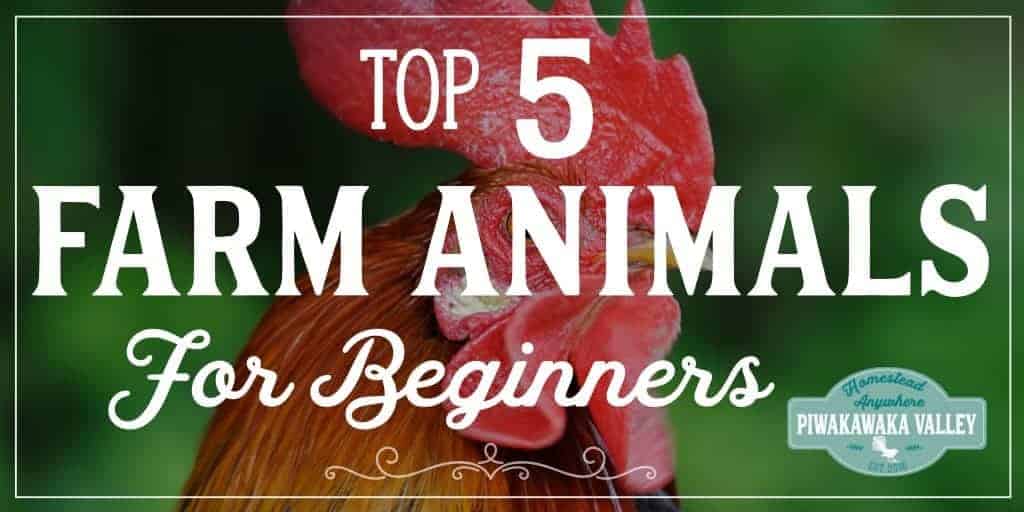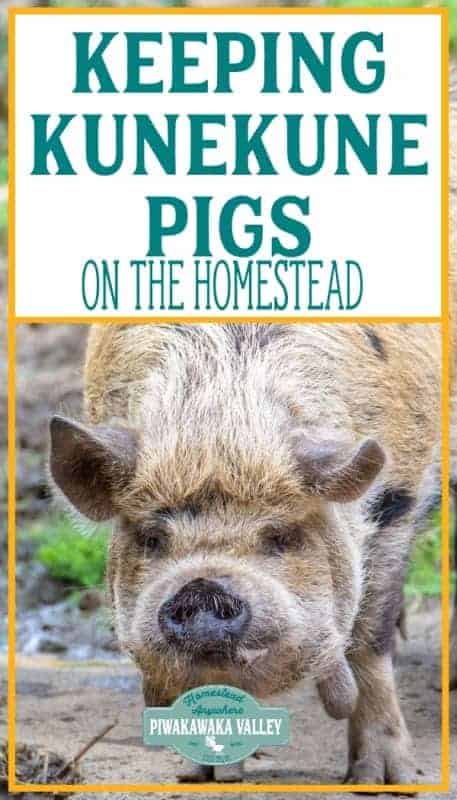This post was most recently updated on July 4th, 2022
On Piwakawaka Valley Homestead we have recently acquired 3 Kunekune pigs. Keeping Kunekune pigs on a homestead is a brilliant idea for many reasons which we will explore below.
Please read: This information is provided for educational purposes only and is not intended to treat, diagnose or prevent any disease. We encourage you to make your own health care decisions in partnership with a qualified health care professional.
This post contains affiliate links, this means at no extra cost to you, we make a commission from sales. Please read our Disclosure Statement
In this post we will look at everything you will need to know when you are deciding if Kunekune pigs are right for you to raise at your place.
What is a Kunekune pig?
Kunekune pigs are from New Zealand and are now found in many places around the world including America and the UK.
It is thought that the Kunekune were probably brought to New Zealand in the 1800’s by whalers operating in New Zealand waters, and were traded with the Maoris. Pigs with similar characteristics occur in Asia, South America, and the Polynesian Islands, but the resemblance is only slight and suggestive of a possible common ancestry.
Kunekune are considered endangered or at risk as they got right down to just 50 pigs in the 1970’s.
The name Kunekune, which is pronounced cooney-cooney, means ‘fat and round’ in Maori, which is a perfect description for this unusual looking pig. The Kunekune is smaller than most other breeds of pigs.
The characteristic Kunekune shape is a short-legged, short-snouted pig with a high fat depth giving a very rounded body shape.
The tassels, or pire pire, are about 4cm/1.5in long and hang from the lower jaw. Not all Kune Kunes have tassels, but it is considered best to have them.
They are a similar shape to a pot bellied pig, but the Kunekune is covered in hair which can be long or short, and straight or curly. Hair colours include black, brown, ginger, gold, cream, and spotted combinations. (1)
RELATED POST: Heritage pig breeds
We love our Kunekune so much, and found many of the “books” available were nothing more than pamphlets or AI generated content, so I wrote my own book on raising and caring for Kunekune pigs. Check it out here.
Do you prefer to watch?
Benefits of keeping Kunekune pigs on a homestead
1. Small
Kunekune pigs are little. While there is no breed standard for size, they are usually about 60cm/2ft tall, but they can vary from 40-70cm.
Kunes can weigh from 60-200kg (120-400lb) so there is a vast range in sizes, but even the biggest Kune is much much smaller than a commercial breed pig.
Because they are smaller you can fit more on your land, and they are often kept in small herds or in urban backyards.
2. Friendly
Kunekunes have a very friendly disposition, they are known for their gentleness and even entire males (boars) make really good pets.
Because of this it is possible for homesteaders to keep both a male and a female to breed their own pigs without all the danger of larger aggressive boars.
3. Eats only grass
Kune kune pigs are best raised solely on grass with the odd treat to keep them tame. Kunes grow slowly meaning that if you give them too much supplemental feed or too many calories each day then they will get dangerously fat.
No one warned us of this when we had a Kune when we were growing up. We over fed poor Betsy and she got so fat her eyelids flopped down and she was blinded by her eyelid fat rolls!
If you breed your own pigs, you can essentially end up with almost free pigs.
Down sides to Kunekune pigs
1. Slow growing
If you are looking for a quick growing pig for meat then Kunes are not what you are looking for. Kunekunes don’t reach full size until about 2 years of age. However because you are feeding the just grass, it is not costing you more to allow them to grow to size.
They do become sexually mature at around 6 months, but it is considered best to not breed them until they are a year old.
2. Small
Even a fully grown Kune is not going to be big, but this makes them easier to handle, and you need less room per pig. Also if you want to butcher them yourself for meat then they are easier to do yourself as you won’t need large winches etc to lift them.
3. Very fatty
Kunekune meat is very fatty, they are considered a ‘lard pig’ which means they are very good fat makers. If you want a lean pork chop then this is not the pig for you.
If, like us, you cook in lashings of healthy, natural lard and you want lard to make soap with, then Kunes are a great choice.
What is a Kunekune pig life expectancy?
Kunekunes can be expected to live about 15 years, with some living up to 20 years. With this to consider, if you are keeping your Kunes purely as pets, it is worth deciding if you can commit to this length of time.
Can Kunekune pigs live indoors?
Kune Kune pigs are as intelligent as dogs (2) and can easily be trained to go to the toilet outside, as well as other tricks like ‘sit’, ‘roll over’ and ‘dance’.
Many people are choosing to let their pet Kunes live in the house, with some moving them outside during the night and while the owners are not home. They prefer to be able to move indoors and out during the day, so make sure there is easy access to the outdoors.
Kunekunes are not ideal to keep in a barn without outside time as they are bred to be raised on grazing grass.
Do Kunekune pigs root?
Kune Kune pigs have very upturned noses, with some variance amongst the individuals in the breed. These upturned noses, when put to the ground mean that the mouth hits the ground first rather than the nose.
This means that MOST Kunekune will not root the ground IF they have sufficient grass to graze on.
Some Kunes with straighter noses may root, it does seem to run in some families. They may go through phases of rooting as they are growing up, and will learn to dig for roots and grubs if they are not kept with ample grass (or hay).
Sometimes Kunekunes need to be nose ringed if they have bouts of rooting up the ground, particularly when there is soft ground after some rain or if there are grass grubs present.
Does ringing a pigs nose stop it rooting?
Rooting is a natural behavior for all pigs, and the Kune kune is no exception. If your Kune kune is a rooter, it can be helpful to try and apply three hog rings – one at 10,12 and 2 o’clock on their snout.
This may or may not stop the rooting. It will deter it for about half the pigs that get it will stop rooting. The rest will continue to root despite the clips or nose rings.
Most pigs that root do so over the winter months when the ground is soft and grass is less plentiful. One way around this is to create a pig pen to use over the winter, and allow your Kune kunes out on the pasture when the grass is longer and the ground is more firm.
How do you take care of a Kunekune pig?
Kune Kune pigs are easy to care for – they need fresh grass, fresh water and shelter from the cold and heat.
For the most part Kunekunes need very little other care. Worming is best done once or twice per year, and they may need their hooves trimmed now and again.
Other than that, the odd treat and lots of belly rubs are appreciated!
RELATED: 5 best animals to keep on the homestead
How do you feed a Kunekune pig?
Kune Kune pigs predominantly eat grass. You may choose to give them a cup of grain, pig pellets or vegetable/fruit scraps each day as a treat to help with taming or training however they do not need this if you don’t want to give them any.
If you are raising your Kune kune for meat, you will probably want to give them a portion of high-protein pig feed twice a day. If this is the case for you, it is best if you keep your meat pigs and your breeder pigs separate so you can feed them appropriately.
What do Kunekune pigs eat in the winter?
If you live in a place that gets covered in snow, or you run out of grass in the winter then you can feed your Kune kune pigs good quality hay with a little alfalfa hay/lucerne added in for extra protein.
If you choose to feed a grain based pig feed be sure that it is 16% protein or less and measure the pigs feed carefully to make sure they do not get too fat.
An adult Kune kune will eat two to three pounds of pellets a day if there is no fresh grass available. You should use equal parts of the pot-bellied pig food and plain grass pellets. You can choose to add hot water to the pellets to create a mash.
How much room do Kune kune pigs need?
How much space a kune kune pig needs depends very much on your soil’s grass-growing abilities. It is generally considered that you can keep 5-6 Kunekune pigs per acre.
This is presuming that your land can grow grass most of the year round, you may need to supplement their feed in the Winter or in Summer if there is a drought.
What shelter do Kune kune pigs need?
Kunekune pigs are not heat tolerant and so need a large area of shade or a well-ventilated shelter in summer. They also need somewhere to shelter from cold winds and snow.
Kunekunes will need a shelter that is big enough to fit them all in with plenty of wiggle room. Make sure it is well ventilated but not draughty, and will keep out the rain.
A solid floor is best, and bedding such as hay, straw, shavings or sawdust can be added for warmth.
If you have a sow (or two, or more) she will need her own farrowing house, preferably with a pen around it where you can keep her and her babies until they are bigger.
If they have the chance, they will make a mud wallow to keep themselves cool and keep the flies off.
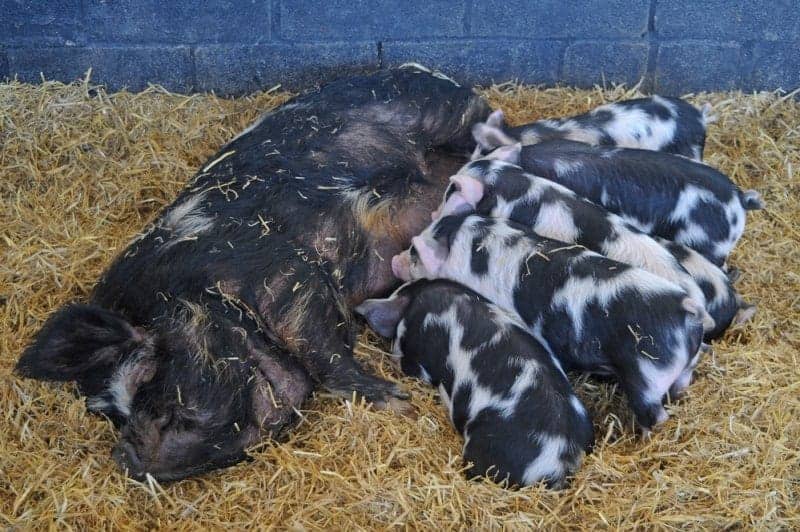
What fencing do Kune kune pigs need?
Good netting fences or electric fences are often needed to keep pigs confined, although a single hot wire can control a well-trained pig.
When teaching piglets about a hot wire it is best to have a solid fence behind the hot wire as many will panic with a zap and run forwards not retreat backwards. Once a pig is trained to a hot wire they will seldom challenge it.
Can Kunekune pigs live with goats?
Yes, Kunekune get on with most animals. Pigs and goats can become good friends. Pigs are very social animals, and it is best to keep at least 2 of them.
Pigs will often eat afterbirths from other animals and may sometimes also take weak baby lambs/goats, so don’t run Kunekunes in with other stock at birthing time!
RELATED: 5 best animals to raise for a profit
Can you eat Kunekune pigs?
Yes, like all animals Kunekune pigs are made of meat so you can eat them. They are not raised commercially for meat because they grow so slowly and are quite small. The sweet flavour of Kunekune pork is enhanced by their grass based diet and comparatively slow growth.
Are Kune Kune pigs good for meat?
Because Kunekune grow slower, their meat is more flavoursome than commercially raised pork. For some this is a great thing, others prefer the tasteless supermarket pork.
One thing everyone agrees on is that Kunekune makes amazing bacon due to all the fat marbling.
Kunekunes are much smaller than commercial breeds making them easier to attempt to butcher them on the homestead yourself. You will get less meat off each pig, but if you are raising them on grass then they are costing you very little to raise.
Because Kunekunes are so hairy, and often have dark skin, they are usually skinned rather than scalded and scraped like other pigs. Skinning isn’t a particularly easy process, however it does allow you to remove the excess fat so that you can render it to lard.
What are kunekune pigs used for?
Kune Kune pigs are often kept on small farms and homesteads either as pets, or as a sustainable, self replicating source of meat. While they are smaller and slower growing than commercial pigs, they also only really need to eat pasture. They are hardy, gentle and great mothers. Many kunekune do not root the soil, but those that do can be used to prepare garden beds for the coming season. Their fat is used for both cooking and soap making and their smaller size makes them more manageable to raise.
For more information about breeding and raising pigs, this book is brilliant. It is written by Wendy Scudamore. Wendy is the Chairperson of the British Kunekune Pig Society and produces their quarterly magazine. Check it out here.

